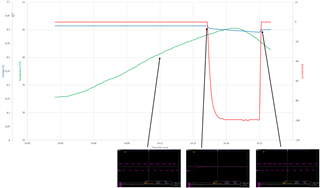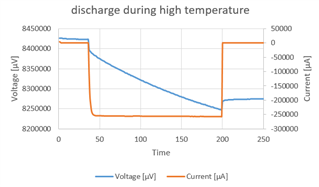hello,
i do have a project with the bq25886 charger. Up till now the charger does what it should.
While temperature change tests i saw a bahavior i could not explain (and no information could be found in the datasheet). This is what i have done:
- RT1/RT2 values choosed based on datasheet (5.24 and 30.31 kR) = (charge temperatures: 0 ... 60 45°C)
- temperature change test in climate chamber -20 ... 60 °C
- battery is fully charged at test begin
- device is powered by external supply all the time
my assumption was:
- the charger will report charge error while temperature is below 0 °C
- battery will stay at 100% RSOC because the device will allway's live from the external power supply
What i found was this:

- green: battery temperature
- red: battery current
- blue: battery voltage
so it could be seen:
- the battery is discharged at temperatures from ~40...60°C -> device lives from battery
- discharge at high temperatures (60°C) is stopped -> device lives from external source
- recharge battery if temp is lower than 45 °C -> device lives from external source
- no discharge at low temperatures -> device lives from external source
- ... and repeat...
The question is: Why does the charger discharge the battery at ~40 ... 60 °C if always a external source is available ?
My guess is:
- The build in JEITA Mode is the reason
- normally the charge voltage is set to 8.4 V (=full battery), but at high temperatures the JEITA mode T3-T5 reduce the max voltage to 8 V (datasheet 8.3.7.4)
- if the charger enters T3-T5 of the JEITA mode but the battery is at 8.4 V, the voltage is to high for the charger and it starts to discharge the battery to bring it down to 8 V
- because of my fast temperature change test the charger leaves T3-T5 of the JEITA mode after a short discharge periode and recharge the battery because 8.4 V max voltage is set again












